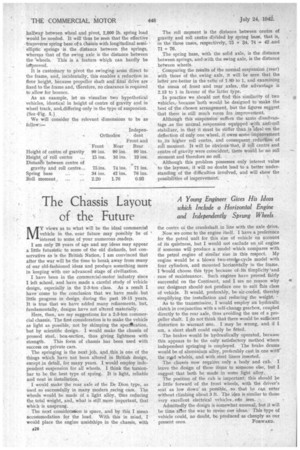The Chassis Layout of the Future
Page 28

If you've noticed an error in this article please click here to report it so we can fix it.
A Young Engineer Gives His Ideas which Include a Horizontal Engine and Independently Sprung Wheels
MY views as to what will be the ideal commercial vehicle in the near futuremay possibly be of interest to some of your numerous -readers. I am only 28 years of age and my ideas may appear a little futuristic to some of the old diehards, but conservative as is the British Nation, I am convinced that after the war will be the time to break away from many of our old-fashioned ideas and prochice something more in keeping with our advanced stage of civilization.
I have been in the commercial-motor industry since I left school, and have made a careful study of vehicle design, especially in the 2-3-ton class. As a result I have come to the conclusion that we have made but little progress in design during the past 10-15 years. It is true that we have added many refinements, but, fundamentally, designs have not altered materially.
Here, then, are my suggestions for a 2-3-ton commercial chassis. The first consideration is to make the vehicle as light as possible, not by skimping the specAcation, but by scientific design. I would make the chassis of pressed steel, box-section, thus giving lightness with strength. This form of chassis has been used with success on private cars. .
The springing is the next job, and this is one of the things which have not been altered in British design, except in detail, for many years. I would employ independent suspension for all wheels. I think the tcusionbar to be the best type of spring. It is light, reliable and neat in installation.
I would make the rear axle of the De Dion type, as used so successfully in many modern racing cars. The wheels would be made of a light allay, thus reducing the total weight, and, what is still more important, that which is unsprung.
The next consideraOon is space, and by this I mean accommodation for the load. With this in mind, I would place the engine amidships in the chassis, with the centre of the crankshaft in line with the axle drive. Now we clime to the engine itself. I have a preference for the petrol unit for this size of vehicle on account
of its quietness, but I would not exclude an .oil engine
if someone will produce a model which compares with the petrol engine of similar size in this respect My engine would be a blown two-strolie-cycle model with four cylinders, and mounted horizontally in the frame. I 'Would choose this type because of.its simplicity 'and
ease of maintenance. Such engines have proved fairly successful on the Continent, and I see no reason why our designers shouldnot produce one to suit this class of vehicle. It would, preferably, be air-cooled, thereby simplifying the installation and reducing the weight.
As to the transtnission, I would employ an hydraulic. clutch in conjunction with a self-change gearbox, coupled directly to the rear axle, thus avoiding the use of a propeller shaft. I do not think that there would be sufficient distortion to warrant one. I may be wrong, and if I am, a short shaft could easily be fitted.
The brakes would be hydraulically operated, .because this appears to be the only satisfactory method where independent springing is employed. The brake drums would be of aluminium alloy, preferably cast in one with' the mad wheels, and with steel liners inserted.
The chassis now recinires onlY a body and cab. I leave the design of these ifems to someone else, but I suggest that both be made in some light alloy.
The position of the cab is important; this should be a little forward of the front wheels, with the drive-r's
seat as low down' as possible, so that he can enter without climbing about 3 ft. The idea is similar to those very excellent electrical vehicles _ one sees.
Admittedly the design is somewhat unusual, but it will be time alter the war to revise our ideas, This type of vehicle could, no doubt, be. produced as cheaply as our
present ones. FORWARD.




















































